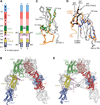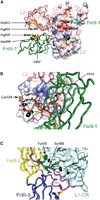Higher-Resolution Structure of the Human Insulin Receptor Ectodomain: Multi-Modal Inclusion of the Insert Domain
- PMID: 26853939
- PMCID: PMC4860004
- DOI: 10.1016/j.str.2015.12.014
Higher-Resolution Structure of the Human Insulin Receptor Ectodomain: Multi-Modal Inclusion of the Insert Domain
Abstract
Insulin receptor (IR) signaling is critical to controlling nutrient uptake and metabolism. However, only a low-resolution (3.8 Å) structure currently exists for the IR ectodomain, with some segments ill-defined or unmodeled due to disorder. Here, we revise this structure using new diffraction data to 3.3 Å resolution that allow improved modeling of the N-linked glycans, the first and third fibronectin type III domains, and the insert domain. A novel haptic interactive molecular dynamics strategy was used to aid fitting to low-resolution electron density maps. The resulting model provides a foundation for investigation of structural transitions in IR upon ligand binding.
Copyright © 2016 Elsevier Ltd. All rights reserved.
Figures



Comment in
-
Interacting with the Human Insulin Receptor.Structure. 2016 Mar 1;24(3):351-2. doi: 10.1016/j.str.2016.02.003. Structure. 2016. PMID: 26933970
Similar articles
-
Solution structure of ectodomains of the insulin receptor family: the ectodomain of the type 1 insulin-like growth factor receptor displays asymmetry of ligand binding accompanied by limited conformational change.J Mol Biol. 2009 Dec 18;394(5):878-92. doi: 10.1016/j.jmb.2009.10.011. Epub 2009 Oct 14. J Mol Biol. 2009. PMID: 19835884
-
A thermodynamic study of ligand binding to the first three domains of the human insulin receptor: relationship between the receptor alpha-chain C-terminal peptide and the site 1 insulin mimetic peptides.Biochemistry. 2009 Jun 16;48(23):5492-500. doi: 10.1021/bi900261q. Biochemistry. 2009. PMID: 19459609
-
Structure of the insulin receptor ectodomain reveals a folded-over conformation.Nature. 2006 Sep 14;443(7108):218-21. doi: 10.1038/nature05106. Epub 2006 Sep 6. Nature. 2006. PMID: 16957736
-
Structural insights into ligand-induced activation of the insulin receptor.Acta Physiol (Oxf). 2008 Jan;192(1):3-9. doi: 10.1111/j.1748-1716.2007.01781.x. Acta Physiol (Oxf). 2008. PMID: 18171424 Review.
-
Insulin receptor structure and its implications for the IGF-1 receptor.Curr Opin Struct Biol. 2007 Dec;17(6):699-705. doi: 10.1016/j.sbi.2007.07.007. Epub 2007 Sep 11. Curr Opin Struct Biol. 2007. PMID: 17851071 Review.
Cited by
-
Symmetric and asymmetric receptor conformation continuum induced by a new insulin.Nat Chem Biol. 2022 May;18(5):511-519. doi: 10.1038/s41589-022-00981-0. Epub 2022 Mar 14. Nat Chem Biol. 2022. PMID: 35289328 Free PMC article.
-
Enhanced anti-metastatic bioactivity of an IGF-TRAP re-engineered to improve physicochemical properties.Sci Rep. 2018 Nov 26;8(1):17361. doi: 10.1038/s41598-018-35407-2. Sci Rep. 2018. PMID: 30478273 Free PMC article.
-
Insulin Receptor Isoforms in Physiology and Disease: An Updated View.Endocr Rev. 2017 Oct 1;38(5):379-431. doi: 10.1210/er.2017-00073. Endocr Rev. 2017. PMID: 28973479 Free PMC article. Review.
-
Insulin signaling in health and disease.J Clin Invest. 2021 Jan 4;131(1):e142241. doi: 10.1172/JCI142241. J Clin Invest. 2021. PMID: 33393497 Free PMC article. Review.
-
Structural mechanism of insulin receptor activation by a dimeric aptamer agonist.Exp Mol Med. 2025 Jul;57(7):1506-1518. doi: 10.1038/s12276-025-01494-1. Epub 2025 Jul 2. Exp Mol Med. 2025. PMID: 40603733 Free PMC article.
References
-
- Adamo M, Raizada MK, LeRoith D. Insulin and insulin-like growth factor receptors in the nervous system. Mol. Neurobiol. 1989;3:71–100. - PubMed
-
- Blanc E, Roversi P, Vonrhein C, Flensburg C, Lea SM, Bricogne G. Refinement of severely incomplete structures with maximum likelihood in BUSTER-TNT. Acta Crystallogr. D Biol. Crystallogr. 2004;60:2210–2221. - PubMed
-
- Boado RJ, Zhang Y, Pardridge WM. Humanization of anti-human insulin receptor antibody for drug targeting across the human blood-brain barrier. Biotechnol. Bioeng. 2007;96:381–391. - PubMed
-
- Bricogne G, Blanc E, Brandl M, Flensburg C, Keller P, Paciorek W, Roversi P, Sharff A, Smart OS, Vonrhein C, Womack TO. BUSTER Version 2.10. Global Phasing Ltd; 2011.
Publication types
MeSH terms
Substances
Grants and funding
LinkOut - more resources
Full Text Sources
Other Literature Sources
Molecular Biology Databases
Miscellaneous

